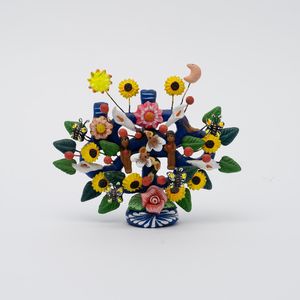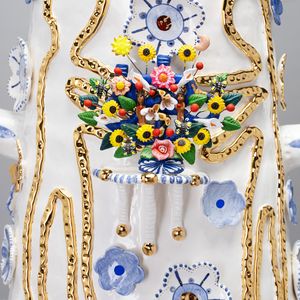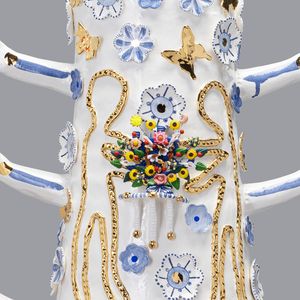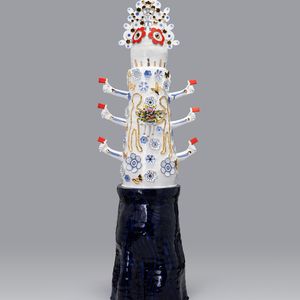Tree of New Life
Tree of New Life inspired by Emiliano's story, 2024
Ceramic and mixed media
$22,000
Vipoo took this broken sculpture and created a new Tree of Life with a large root system symbolising Emiliano’s settlement in Australia. He also made a small altar for the original tree, featuring two golden figurines representing Emiliano and his Australian partner caring for the tree and their new life as a couple.
EMILIANO'S STORY
My name is Emiliano. I am an Architect and I now live in Sydney, Australia.
I moved to Australia 13 years ago, when I was 21. I wanted to experience a different type of life. The conditions were not right at home for me to become the person I wished to be, both as an individual and a professional, and I felt I needed a radical change. From when I was young, I craved many of the liberties that Australia had to offer.
I was 10 when the Olympics were held in Sydney. I remember seeing a TV show for children about the everyday life of school students in Australia – a visit to the beach in the morning before class, and a bush walk in the afternoon before bed. I realise now that the program employed some creative license, but the prospect was enchanting to a young person living in Mexico City, a tightly packed and sprawling, concrete metropolis.
Mexico City accommodates more than 26 million people, with everyone energetically jostling for space. Although Sydney is a vibrant place, it is much calmer than my city. When I first arrived, it was a dream-like vision, as if looking through rose-tinted glasses. Soon I understood that Australia also had difficult issues to contend with.
The process I experienced obtaining my visas (three student visas, one working, one skilled, and a citizenship) was complicated by my nationality. The administrators asked a lot of me – to undergo numerous police checks, and to divulge intimate details about my parents, grandparents, and great-grandparents. These requirements were different to those that my peers and co-workers moving from Europe and America were facing. I naively ignored a lot of red flags as I wanted to ensure the success of my stay in Australia. The applications cost tens of thousands of dollars over many, many months, a significant expenditure of time and money that I negotiated alongside full-time study and work. My parents, reckoning with their own financial stresses and an exchange rate of 14 Mexican pesos to 1 Australian dollar, generously offered whatever they could.
What did you feel about moving to Australia?
From the moment I arrived, I knew I wanted to stay and make my life here. The excitement propelled me forward and enabled me to reinterpret obstacles as opportunities. The chance to begin anew was intoxicating, making me feel as though I could achieve anything. Although reality quickly set back in, I still remember what that time was like.
What advice would you give to someone moving to Australia?
While it’s very important that you take root and enjoy the fruits of a new life, you must be receptive to new responsibilities – to listen and learn from the country’s First Peoples, and to find opportunities to support the communities for whom the ‘Australian dream’ is not readily accessible.
What Australian culture do you love?
It's difficult to pick just one thing that I love about Australia. I admire that food here is used to invite people to engage with cultures beyond their own. Food allows us to share our stories and start new conversations with others – about the climate, history, politics, and so on. Most important to me was finding my partner and friends here.
OBJECT
My object is a traditional Mexican 'Tree of Life', crafted from fired clay. Trees of Life are made in a town close to Mexico City called Metepec using Indigenous pottery techniques. In contrast to their fabrication, these ceramics have historically portrayed a colonial and biblical scene – Adam and Eve in the Garden of Eden. The object blooms the religious narrative from a tree-shaped structure, which is adorned with sculpted flowers, fruits, butterflies, and the characters from the parable.
The religious origins of these objects have largely been detached in recent years and Trees of Life now depict all kinds of secular iconography. With this, their meaning has changed. Once gifted primarily to newlyweds to promote fertility, they have become decorative objects for housewarmings and as a gesture of well wishes. The tree I have was given to me by an aunt as a farewell gift, a token of good luck for my journey to Sydney. She told me to take care of it so I wouldn’t forget where I came from.
These objects are very delicate and break easily. They’re handcrafted and can be expensive for a working-class family like mine. When I unpacked on my arrival in Sydney, I found that beneath the bubble wrap and folded t-shirts, a branch had chipped.
I had set out to honour my aunt’s wishes and to protect the gift at all costs on my journey. Yet the broken limb came as a relief, as if a sign that I should prioritise my own happiness for the first time instead of the cultural responsibilities that I had inherited. I kept the tree and promised that I would repair it when I found the time.
Thirteen years later, I have not fixed it, however I have carried it with me ever since. I like it more as a broken object as it gives me a chance to oblige the family mandate on my own terms. What has made my migration to Australia both meaningful and sustainable is the ‘breaking’ of old rhythms and habits, and the flourishing of new ones.
Image top: Vipoo Srivilasa, Tree of New Life, 2024 Photo: Simon Strong




